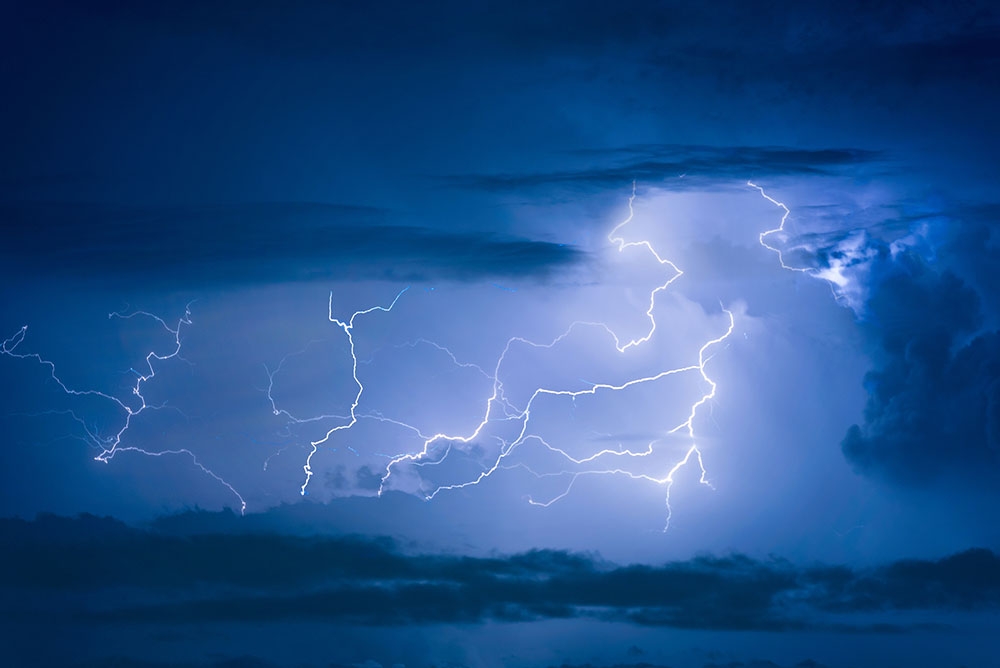During the summer in the Sea of Cortez, it is not only excruciatingly hot- there are Chubascos to worry about. A Chubasco is a suddenly-occurring, localized storm that brings thunder, lots of lightning, very strong winds and often lots of rain as well. Winds can rapidly kick up in a matter of minutes, bringing 40-50+ knots of wind before you even know what is happening.
The best thing to do with the Chubascos is to try to predict them so that you can prepare for them. The best resource that we found was www.eebmike.com. On this website, which is updated regularly, you can see the storm patterns. We found that when we saw a lot of red on the mainland side of Mexico and the red was spreading West (especially over the water) then a Chubasco was likely to occur that evening. Chubascos typically hit in the late evening to early morning (yes, when you are sleeping!) so it is best to try to know of their possible presence in advance. If you suspect a Chubasco based on what you see, then prep your boat. Remove as much windage as you can. Lash loose items down securely and bring any cushions, etc. from your cockpit inside so you don’t lose them. If you are at anchor, make darn sure you are set really securely and have a secondary anchor ready to deploy, should you need it. It’s also a good idea to bring your dinghy onboard- up onto the davits or lashed to your bow. Don’t leave your dinghy in the water, or it is very likely to flip over or be lost. If bringing your dinghy onboard isn’t possible, then the next best thing would be to remove your outboard if you’ve got one and fill your dinghy up with some sea water to weigh it down.
Also be sure to close up any hatches or port lights that may allow rain through or you may find you have an instant puddle in your boat or worse- yet, soaked clothing or bedding!
While in Santa Rosalia, it was so hot that we were sleeping in the cockpit. When a Chubasco would hit in the night, we found there was a precursor of sudden gusts of wind that would wake us up just in advance of its arrival. Within 2-3 minutes, the Chubasco would be upon us, unleashing all of its fury. They really are like miniature tropical storms as they swirl about in a counter-clockwise direction, testing your dock lines and cleats. Lots of fenders are recommended if you are at a dock and be mindful of your rigging next to your neighbour’s!
Here is a quick checklist for prepping yourself for a possible Chubasco:
- Add some extra fenders if you are at a dock. Fenders on both sides is probably a good idea. You never know.
- Check all dock lines to ensure they are secure. Add extras as well as some snubbers if you have them. Check cleats on both the dock and your boat as well.
- Ensure your mast and standing rigging is not aligned right beside your neighbor’s. It is a good idea to stagger them, in the event that your boat rocks a lot due to stirred up seas.
- Remove as much windage as possible- sun shades, boom tents, wind scoops, etc.
- Lash any loose items down- jerry cans, dinghy, generators, etc.
Secure your dinghy! Bring it up on its davits, lash it to the bow or deflate it and stow it. If these aren’t an option and you must leave it in the water- remove the outboard and fill the dinghy with some sea water to weigh it down. Ensure you have an extra ‘safety’ line attached to your dink so that it doesn’t float away on you.
Take all loose towels, blankets, cushions, hatch covers and other light items inside and stow them so that they do not blow away.
If you are anchored- be sure you have a secondary anchor ready to deploy, should you need it. It might also be a good idea to have an anchor watch app with an alarm set, in case you do drag anchor. We had friends in the summer of 2017 who turned off all of their electronics and stowed some in their oven in case of lightning and dragged anchor two miles in the Bay of Concepcion without even realizing until the storm was over.
If you have any loose items on the dock like bicycles, etc., ensure that they are stowed safely or secured to your boat. We once saw our neighbour’s bike flop right into the water during a Chubasco because the dock was rocking so much and the bike was not tethered to anything.
Close all hatches and port lights that could create problems for you with torrential amounts of water pouring in them… or perhaps this could be a good opportunity to catch a little rain water?
One final note- if you have an SSB radio, you can tune into the Sonrisa net, which discusses the possibility of Chubascos each evening. Essentially, the net host is interpreting the data on EEBmike.com though, so you could listen to hear what he/she has to say and then look at EEBmike.com yourself to see what you think. Soon, you’ll get pretty good at predicting their arrival.




